Table of Contents
Introduction
Light pollution is a widespread problem that has received little attention in comparison to other environmental issues such as air and water pollution. It refers to the excessive or misdirected artificial light that interferes with our natural nighttime environment. While light pollution may seem harmless, it has serious implications for our planet, including the acceleration of climate change and energy waste.
In this article, we will explore the impact of light pollution on the climate crisis and energy crisis. We will also offer practical solutions to reduce light pollution and promote a more sustainable future. And how the Turn Off the Lights browser extension and the desktop app can help reduce light pollution and save energy.

Causes of Light Pollution
- Urbanization and Development:
The rapid pace of urbanization and development has led to the spread of artificial light in cities, towns, and villages. Bright lights from buildings, streetlights, and vehicles contribute to light pollution, which is exacerbated by the use of low-quality lighting fixtures.
- Outdoor Lighting:
Outdoor lighting, such as streetlights and security lights, often uses outdated technology that emits excessive and harmful light. This type of lighting is not only wasteful but also contributes to pollution.
- Advertising and Decorative Lighting:
Advertising and decorative lighting are often designed to attract attention and create a visual impact. These lights are often overused, poorly directed, and consume a significant amount of energy, contributing to light pollution and energy waste.
Consequences:
- Climate Change:
It contribute to climate change by increasing the amount of carbon dioxide emitted into the atmosphere. This is because excessive artificial light requires more energy, which is often generated from fossil fuels.
- Energy Waste:
It is a significant source of energy waste. It is estimated that up to 30% of outdoor lighting is wasted due to misdirection, overuse, and inefficient fixtures. This results in higher energy bills and unnecessary carbon emissions.
- Ecological Disruption:
It can have a profound impact on wildlife, disrupting natural patterns of behavior and migration. For example, sea turtle hatchlings use the light from the moon to guide them to the ocean. However, artificial light can disorient them, leading to a high mortality rate.
Solutions to Light Pollution:
- Use LED Lighting:
LED lighting is an energy-efficient and cost-effective alternative to traditional lighting fixtures. It emits less pollution and lasts longer than other types of lighting.
- Install Motion Sensors:
Motion sensors can detect movement and activate lights only when necessary. This reduces the amount of wasted energy and pollution.
- Use Shielded Fixtures:
Shielded fixtures direct light downward and reduce it. This type of lighting also enhances visibility and reduces glare.
Software
How the Turn Off the Lights Browser Extension and Desktop App can Help:
- Reducing Light Pollution:
- The Turn Off the Lights browser extension and desktop app darken web pages, reducing the amount of light emitted by devices.
- This reduces the amount of artificial light that spills into the environment, reducing pollution and its impact on the climate and energy crisis.
- Saving Energy:
- By reducing the amount of light emitted by devices, the Turn Off the Lights browser extension and the desktop app also help save energy and reduce energy costs.
- By darkening web pages, the app and extension also reduce eye strain, providing a more comfortable viewing experience while also saving energy.
YouTube video biodiversity
Conclusion
Light pollution is a growing crisis that has serious implications for our planet. It contributes to climate change, energy waste, and ecological disruption. By taking practical steps to reduce pollution, such as using LED lighting and shielded fixtures, we can create a more sustainable future and protect our natural environment. Let’s work together.
If you find it useful about our Environment, then you can share the link on Facebook or share the link on Twitter. So your family, friends, or colleagues can know about this handy free tool.
FAQ
What is the difference between natural and artificial light?
Natural light is produced by the sun and is an essential part of our circadian rhythm. Artificial light is created by humans and can interfere with our natural nighttime environment.
How can light pollution be harmful to human health?
Exposure to excessive artificial light can disrupt our sleep patterns and cause eye strain and headaches.
How can I reduce light pollution in my community?
You can reduce pollution by using LED lighting, installing motion sensors, and using shielded fixtures.
What is the Turn Off the Lights Browser Extension?
The Turn Off the Lights Browser Extension is a free, open-source tool that darkens web pages to reduce eye strain and save energy.
Is the Turn Off the Lights Desktop App free?
While the Turn Off the Lights Browser Extension is free, the desktop app is a premium tool that offers additional features, including the ability to darken your entire screen and customize your viewing experience.
Can the Turn Off the Lights Browser Extension and Desktop App reduce light pollution in my area?
While the Turn Off the Lights Browser Extension and Desktop App cannot directly reduce pollution, they can help reduce the amount of light emitted by devices, which can indirectly reduce pollution and its impact on the environment.
Did you find technical, factual or grammatical errors on the Turn Off the Lights website?
You can report a technical problem using the Turn Off the Lights online technical error feedback form.